Red mushrooms tend to stand out immediately in the forests most grow in. Often growing on the ground among dead leaves or on green moss, they stand out more than other mushrooms.
Some of these red mushrooms are also found in The United States. Many grow in Europe, Australia, and all around the world except Antarctica.
Red mushrooms listed below can be edible but a few of them are highly poisonous.
Table of Contents
1. Fly Agaric
Fly Agaric mushrooms (Amanita muscaria) are some of the most popular types of red mushrooms in popular culture.
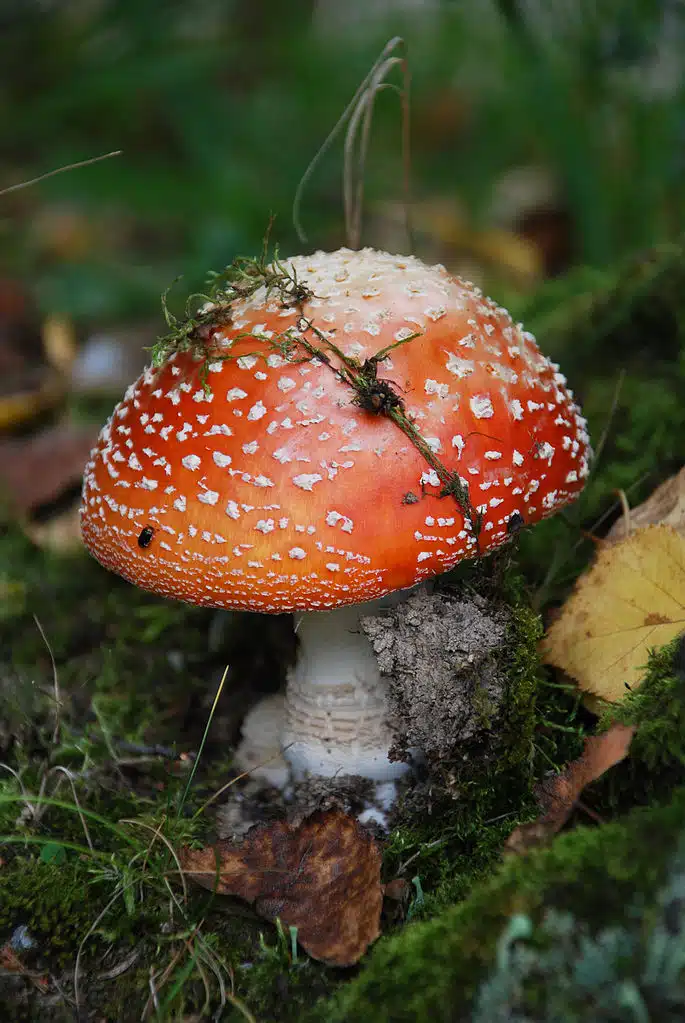
They are known for their appearance in movies and video games such as The Mario series.
While common in pop culture, these mushrooms are still poisonous.
Consumption of these mushrooms comes with hallucinogenic effects.
Still, they are eaten in some parts of the world. Boiling them and then boiling them a second time is believed to considerably reduce their poisonous profile.
Known for their red appearance with white spots, the mushrooms also have different other uses such as insecticide.
Mixed with a carrier liquid, the mushroom eventually turns bugs and other insects away from crops.
2. Blood Red Russula
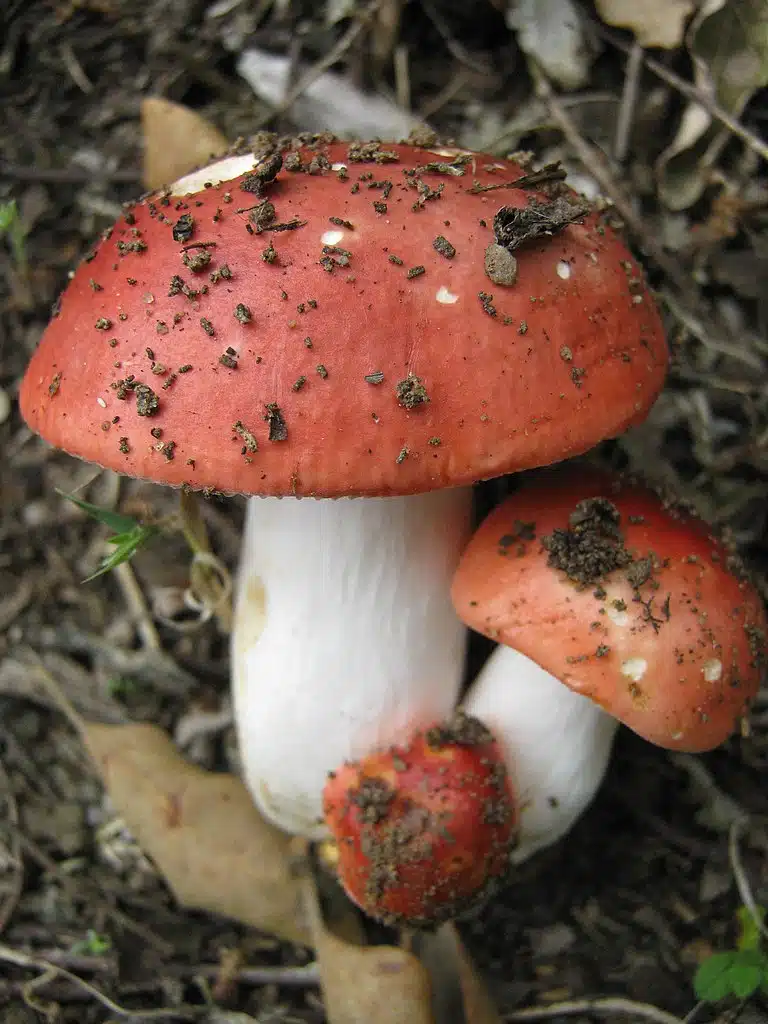
Blood red and dark red nuances are specific to The Blood Red Russula (Russula rosea).
The cap of the species shows deep red coloring while the stem is mostly white, partly red, and rarely only white.
The age of this mushroom may also be approximated by the nuance of the cap, which turns pale as it matures.
Its flash is always white while the cap itself grows to a size of 3-4.5 inches at best.
As a type of fungi, Blood Red Russula cannot be eaten and they have a quite bitter taste.
3. Red Chanterelle

A bright red cap and a matching red stem are specific to the wavy-looking Red Chanterelles (Cantharellus cinnabarinus).
These types of mushrooms also show at least a couple of white irregular-shaped spots on the stems.
Native to Eastern North America, they offer low interest in the edible space, mainly due to their high water content.
These mushrooms are rarely cooked on their own and are mainly combined with sauces and butter.
As Blood Red Russula, these types of mushrooms are mostly found in areas of the forest or next to hardwood trees.
Mixed forests and even evergreen forests in the Eastern parts of North America are also home to this species.
4. Ruby Bolete
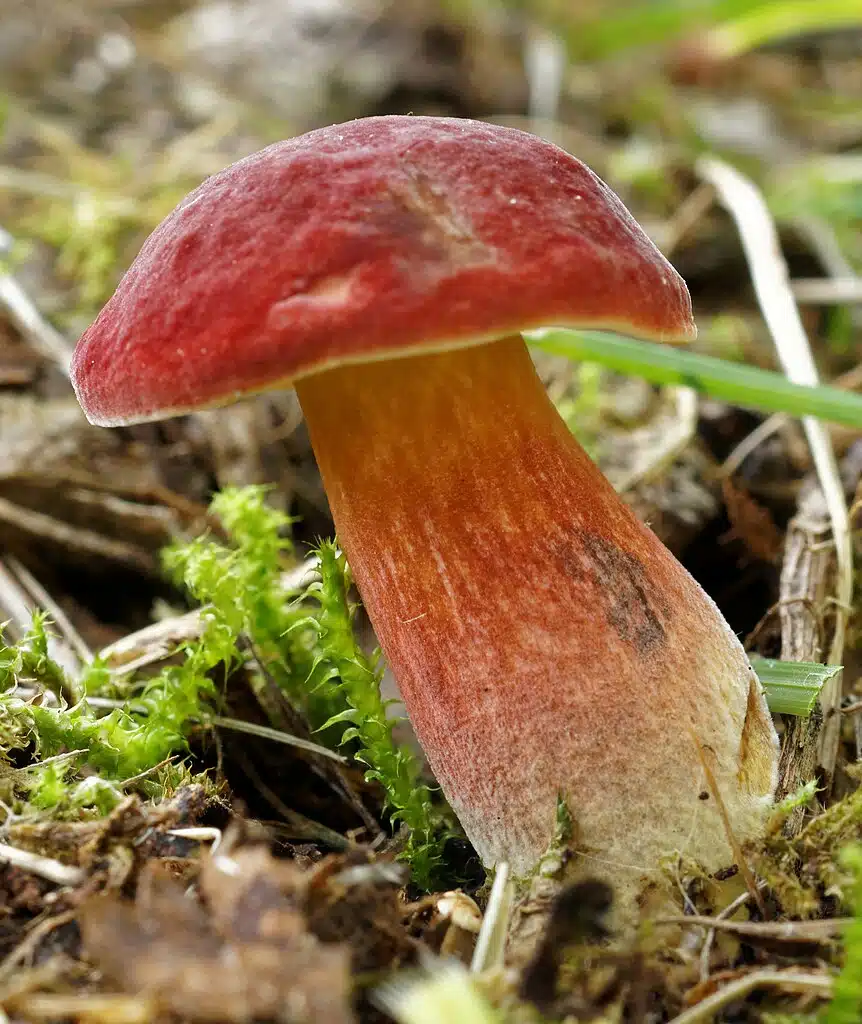
Red nuances are specific to the cap of Ruby Boletes (Hortiboletus rubellus). Scarlet is the vivid nuance of these mushrooms which show the porous nature of the cap.
Yellow flash and a yellow cap underside are specific to the mushrooms.
The stem shows a combination of scarlet and red nuances, as stripes.
Not edible and largely poor-tasting, Ruby Boletes have an unpleasant plastic-like taste which is often compared to soap.
The mushrooms are associated with hardwood trees and hardwood forests of oak or mixed oak forests.
Also growing in parks and gardens with oak, Ruby Boletes are mushrooms with a maximum expected height of 3.9 inches.
5. Two-colored Bolete
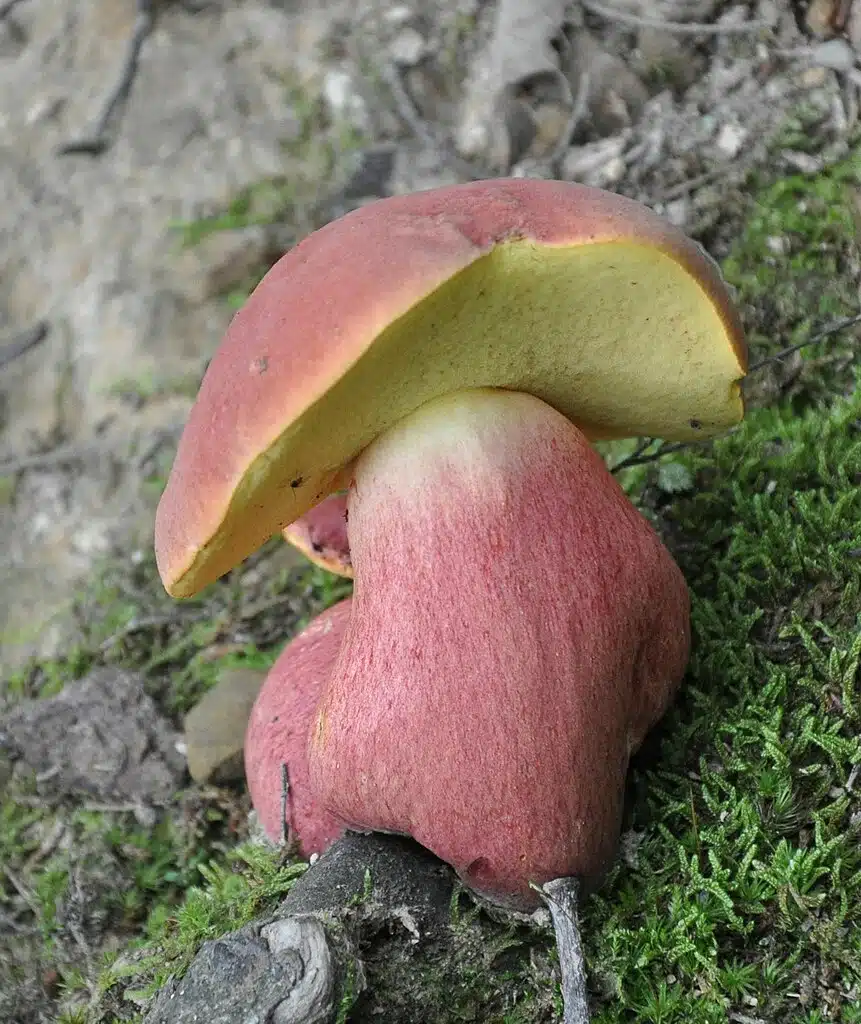
Red and yellow dual colors are characteristic of The Two-colored Bolete (Baorangia bicolor).
These types of mushrooms show a dark red cap and a yellow and red stem. The porous underside of the cap is also yellow.
Partly edible, the mushroom itself doesn’t have a strong taste. Drying and boiling are among its most common cooking methods.
The Two-colored Bolete is a species that may be consumed once truly red, as this marks its mature stage when it’s less common to be inedible and even packed with larvae.
One of the older techniques of breaking the cap and waiting for it to bruise after a long time is used to distinguish the species from other inedible mushrooms which tend to bruise quickly or even instantly.
6. Painted Suillus
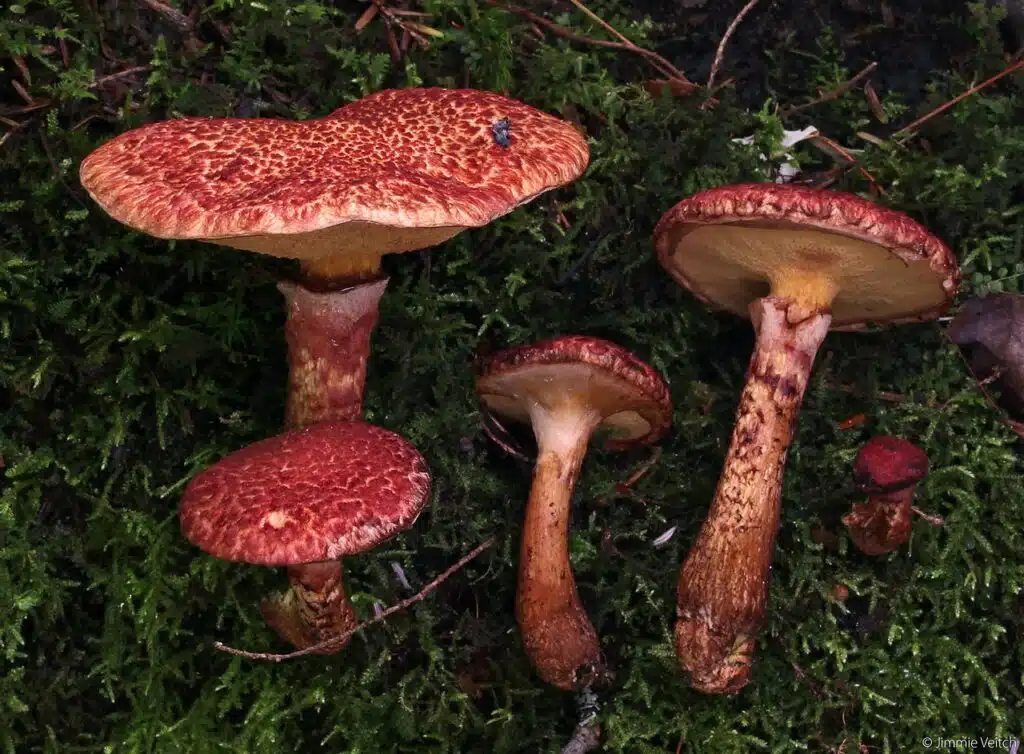
Painted Suilluses (Suillus spraguei) are known for changing the shape of their red and yellow caps as they grow.
From an initial conic shape, they eventually flatten out and may grow to a diameter between 2 and 4 inches.
A red and yellow stipe is specific to these mushrooms which additionally shows a ring in the upper part.
Growing in North America’s pine forests, these types of mushrooms are always associated with different species of pine.
They are edible but their taste is somewhat disputed. Its slime-like texture and the blackening of the mushroom when cooked can put some people off.
On the other hand, they are considered among the better-tasting types of suilluses when not affected by mold.
7. Jackson’s Slender Caesar
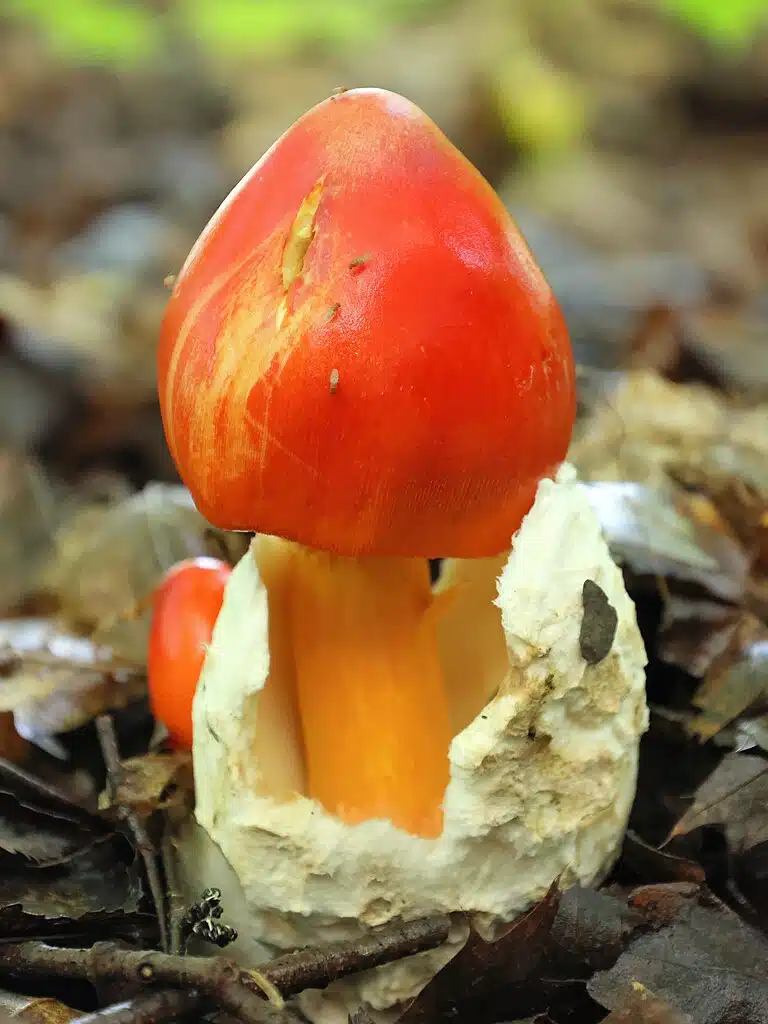
A species of hardwood forests in Europe and North America, Jackson’s Slender Caesar (Amanita jacksonii) is among the flattened cap types of mushrooms.
Its flat cap does show a central bump or raised area and features a mostly orange-red color with a darker central area that eventually turns gradient orange to the sides while the margins of its cap are yellow.
The mushroom may also have a concave cap in its early growth stages.
It doesn’t bruise and it’s considered edible.
The taste and smell of the species are not strong or particularly memorable. While edible, it does not represent one of the go-to species of mushrooms.
Much of its North American range is tied to the forests of the Eastern continent with either oak or pine trees.
8. Chip Cherries
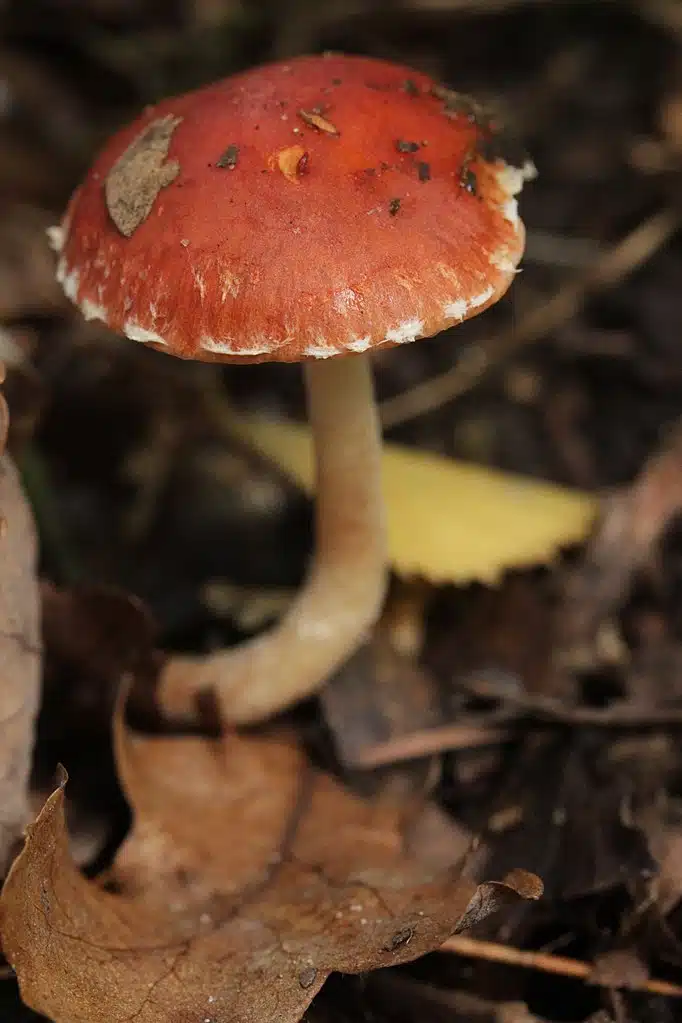
Growing on wood chips, Chip Cherries (Leratiomyces ceres) are found across North America, Europe, and Oceania.
These types of mushrooms have an orange-red cap and a white stipe. A white ring is also present on the stipe, closer to the cap.
A concave cap tends to darken with time for the species.
Chip Cherries are mostly associated with wood chips in the forest but their edibility is not known.
The types of forests it grows in include hardwood forests and pine forests.
It’s here that the mushrooms grow through the summer, up until October when they’re already typically darker.
9. Scarlet Waxy Cap
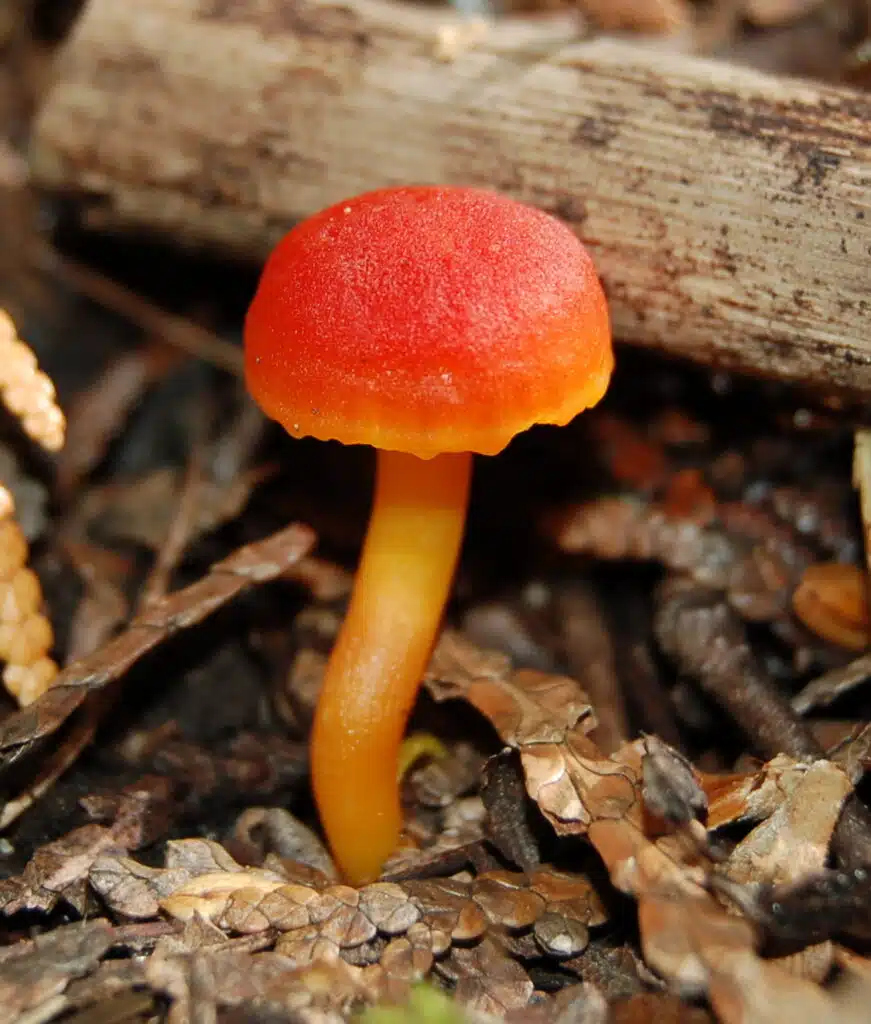
Scarlet red coloring makes this type of mushroom stand out. Its red cap is matched by a mostly red stipe.
A brighter yellow nuance is specific to the lower side of the stipe.
Even the shape of the cap changes as it grows. It has a bell shape in its early days and a flattened shape as it grows.
This is a type of mushroom that likes late fall, especially during periods without freezing temperatures, even in the winter.
The scarlet waxy cap mushroom (Hygrocybe coccinea) is considered partly edible or its cap is seen as edible, but without a particularly memorable taste.
In North America, these late-season mushrooms are found in the Western states in forests such as those of oak, redwood, and mixed species.
Its presence is also signaled in India and Australia.
10. False Caesar’s Mushroom

A quite common type of mushroom, False Caesar’s Mushroom (Amanita parcivolvata) is poisonous and shouldn’t be touched.
This is a type of mushroom that grows in parks, next to roads, on grassland, and occasionally in forests.
It can be identified by its atypical type of cap which is bell-shaped and then turns flat.
It features red-brown coloring with additional yellow warts. The warts are concentrated towards the inner part of the cap.
The toxins within this mushroom are believed to be dangerous. Accidental ingestion of these toxins may even be deadly.
The mushrooms can also be identified by their solitary growing pattern as they rarely appear in clusters.
Other specifics such as smell alone cannot be used for identification as it doesn’t have a noticeable scent.
11. Frost’s Bolete
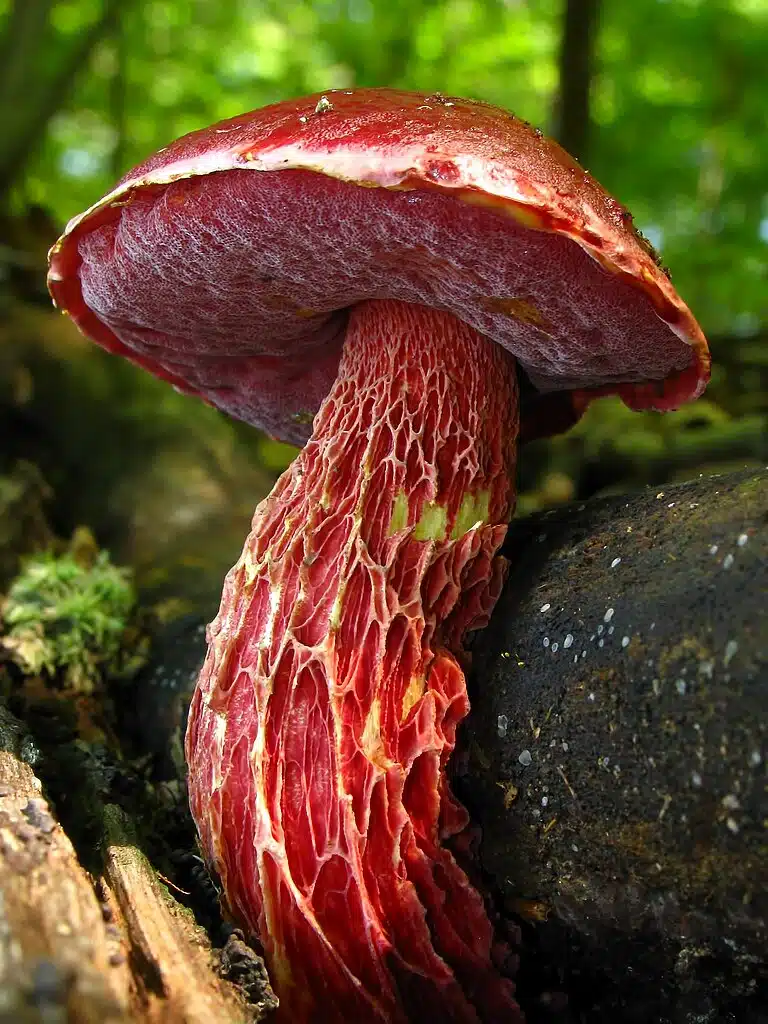
Frost’s Bolete (Exsudoporus frostii) grows in North and Central America. It can also be found in tropical forests.
A vivid red cap and a matching red stipe are specific to these types of mushrooms. The stipe tapers towards the cap and has a porous appearance with visible red and white coloring.
The margins of its red cap are also white. When it comes to the shape of the cap, it largely varies from flat to convex.
Mushrooms of the species turn blue when bruising. Despite this, they are edible.
Scientific literature generally steers towards staying away from the mushrooms as they look too similar to other red ones that are highly poisonous.
The taste of Frost’s Bolete is described as sweet and mildly citrusy.
Finding the mushrooms in stores may not be common but the species is sold in some remote markets of Central America.
12. Vermilion Waxcap
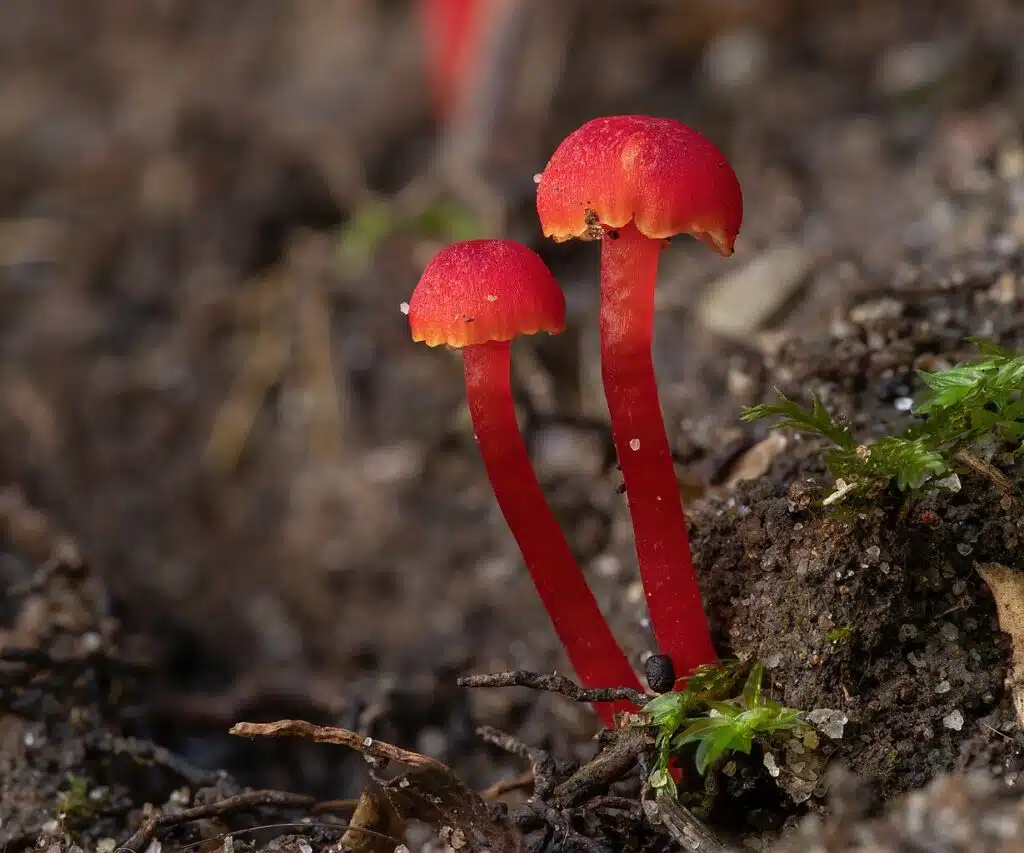
Mostly red and believed not to be edible, Vermilion Waxcap mushrooms (Hygrocybe miniata) are specific to late fall.
This is a species of North America, Europe, and Australia where it appears late into the season and into the winter if there’s no frost.
Mostly associated with types of weeds, it can grow in different fields where there’s not much interest in terms of agriculture and industrialization, in parks, and at the edges of woodlands.
It features a dome-shaped cap with a bright red color and yellow margins which may flatten with time.
Stipes are also mostly red, fairly similar in thickness from the bottom to the cap, but slightly brighter red towards the cap.
While its edibility status is unclear, the species can also be identified by its location in eucalyptus forests, bright red overall appearance, as well as its strong garlic-like scent.
13. Goblet Waxcap
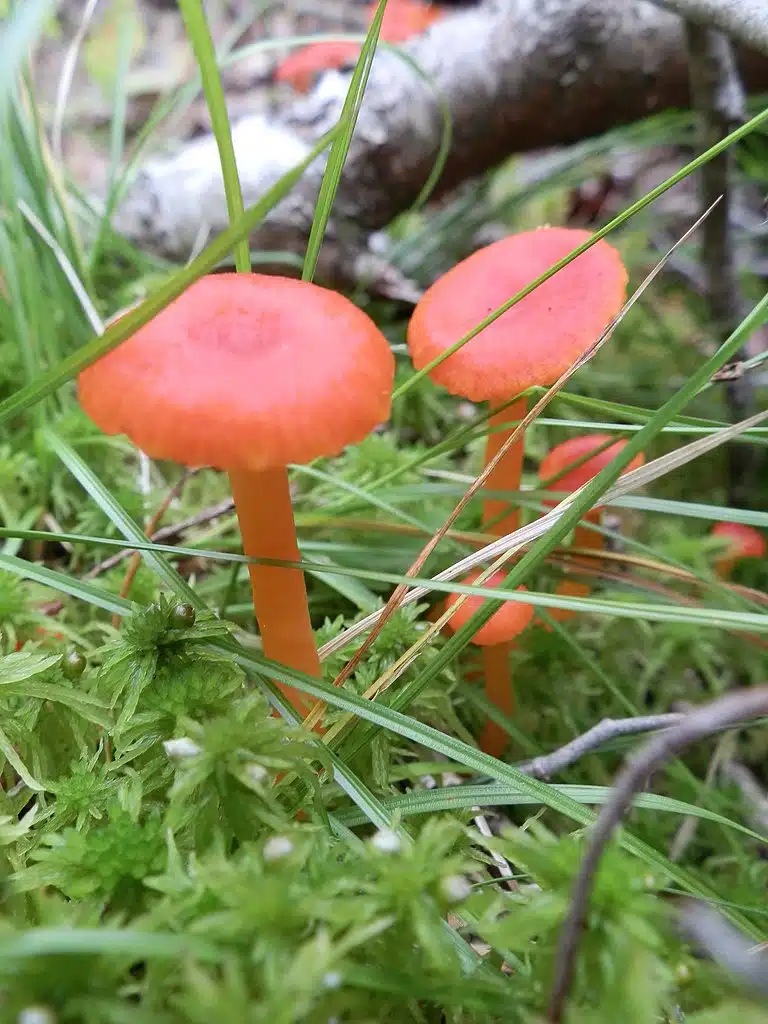
Goblet Waxcaps (Hygrocybe cantharellus) are found in Europe and North America. Often associated with mossy fields in Europe, the species grows in woodlands across North America.
A small type of mushroom, it may only grow to a diameter of a couple of inches.
Its cap eventually becomes flat and has an almost uniform red or red-orange color.
Its gills are bright yellow at first, brightening over time.
Stipes are also bright red or red-orange, matching the color of the cap.
Fairly light by nature, they are sometimes reported as edible. However, there isn’t much substance to them and they are rarely picked in their natural range.
The fact they grow around dead plants and mosses may also impact their taste, which isn’t great either.
14. Witch’s Hat
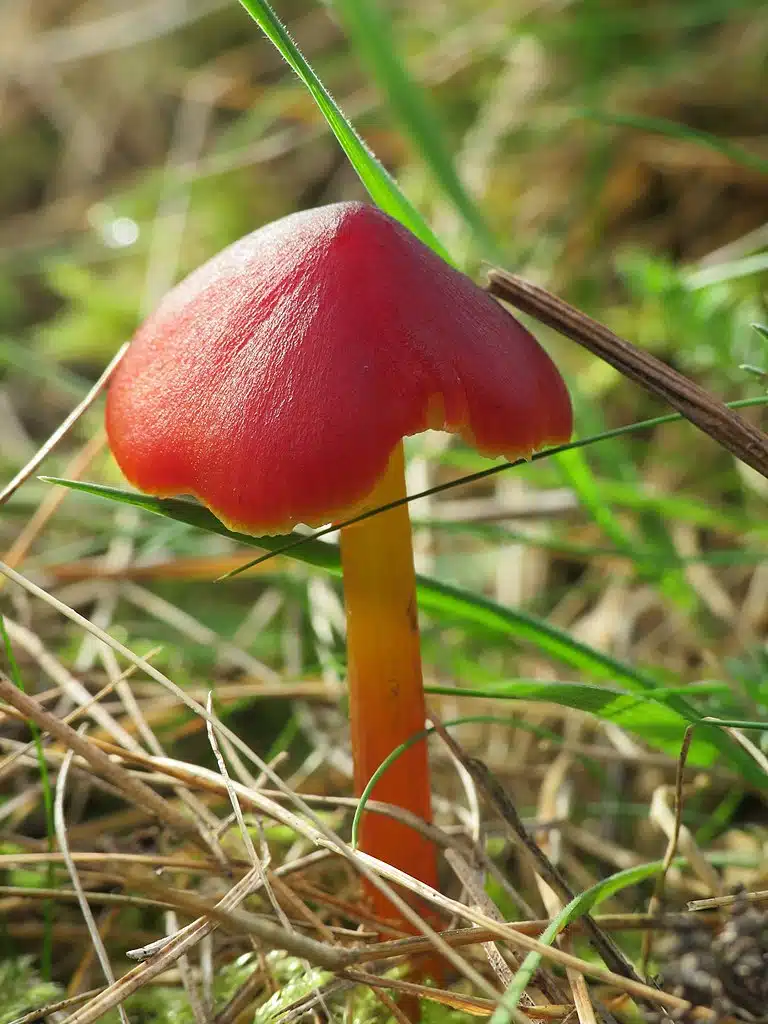
Witch’s Hats (Hygrocybe conica) are types of mushroom with a cone-shaped cap that resembles those of a witch.
These mushrooms were primarily found in Britain and Europe in specific waxcap grassland but are also found in coniferous woodlands across North America.
Mushrooms of the species face a diminishing habitat as their grasslands are quickly turned into agricultural land.
Moss-rich grassland with short grasses that support mushroom growth is becoming a rare sight for this species to grow in.
A species known to be poisonous, The Witch’s Hat mushroom has a red cap and a white stipe but may also be found in a red matching stipe.
Most common sightings include the roadside along different woodlands, grasslands, and fields where no fertilizers have been used.
15. Winter Russula

Winter Russulas (Russula cremoricolor) grow to a size of 3.9 inches, being some of the common European and North American red and white mushrooms.
The cap is entirely white and convex. It grows and flattens out. Some of the larger caps of these mushrooms may also show a lower central area once the cap is fully grown.
White stipes are specific to this species and they show a straight profile without tapering or rings.
This species has mixed reviews when it comes to its edible status. Literature in Europe mostly recommends it as edible while literature in North America doesn’t recommend eating the mushroom.
Its resemblance to The Sickener (Russula emetica) is what mostly makes this species a bit more difficult to correctly identify.
16. Red Pinwheel
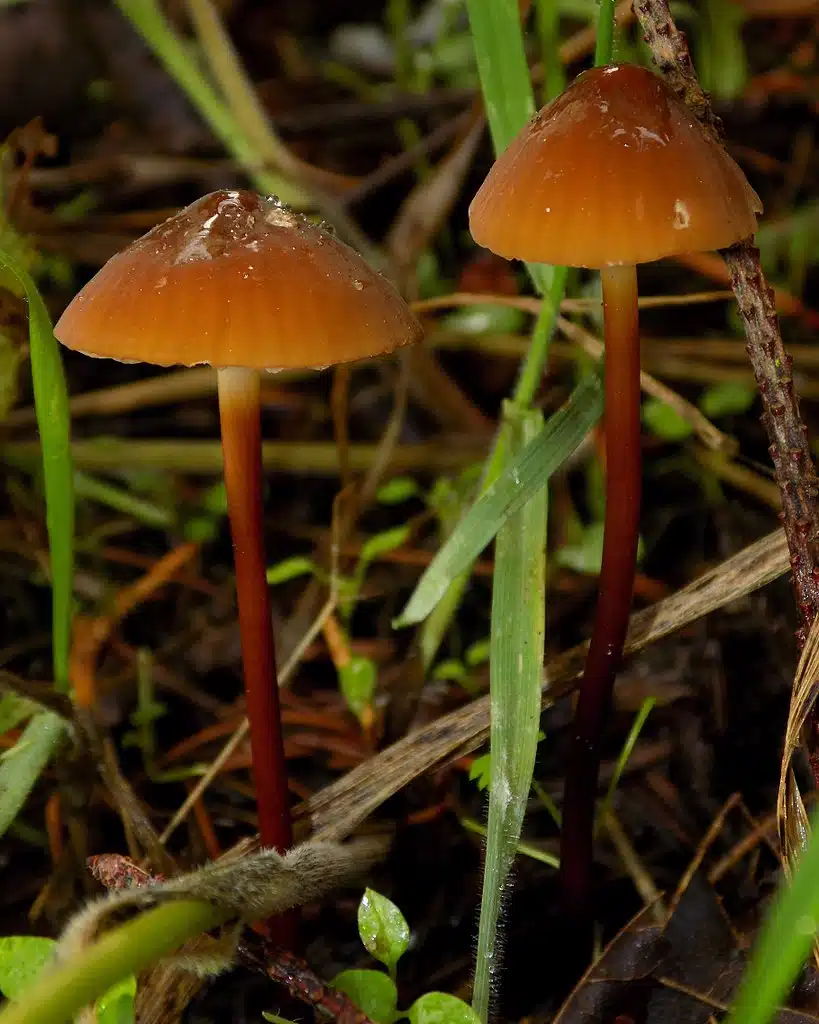
Mostly found West of The Rocky Mountains, Red Pinwheels (Marasmius plicatulus) are small mushrooms of a mahogany-red nuance.
Most Red Pinwheels are found in the forests of California.
These types of mushrooms have a bell-shaped cap which is rather small, with a diameter of up to 2 inches.
Its stipe also has a mahogany color with a brighter nuance closer to the cap.
Specific to woodlands, it grows in oak areas and places with plenty of dead leaves on the ground.
Its gills are brighter pink and sometimes white.
The edible status of these mushrooms is unclear, but they aren’t believed safe for human consumption.
17. Redhead Russula
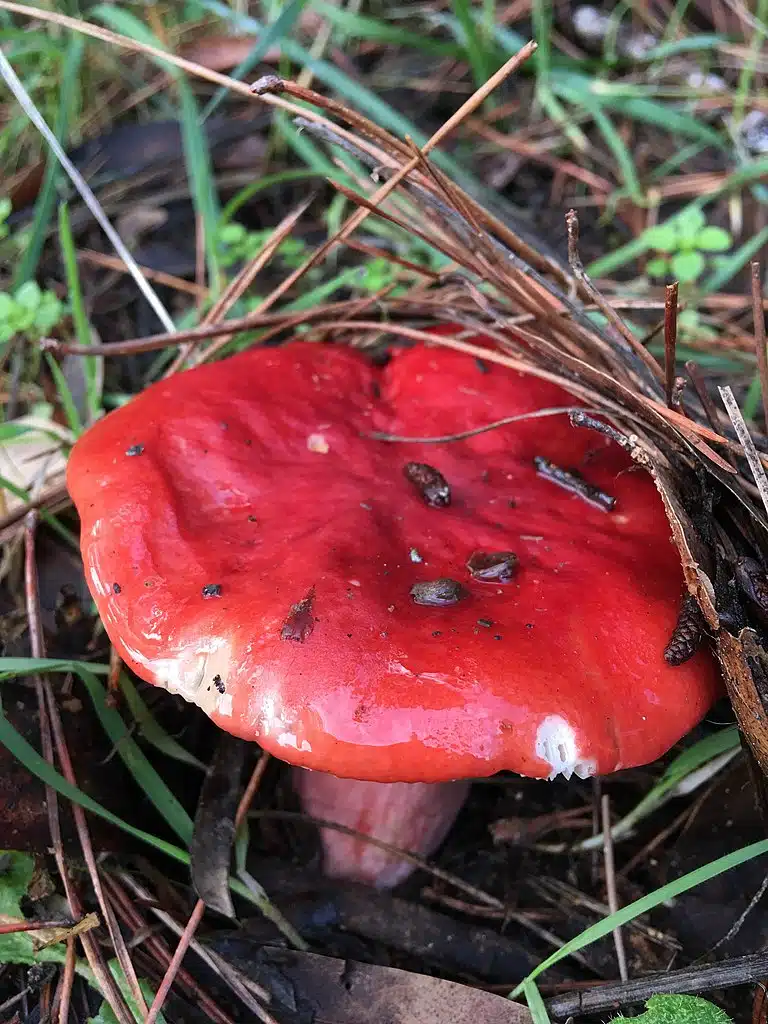
Large and known for its red flat cap, Redhead Russulas (Russula rhodocephala) are found across multiple continents.
These mushrooms are also found in The United States, with a preference towards the Western and Southwestern US forests.
They grow around hardwood leafy trees but also on lawns and even around individual trees in parks and gardens.
Identified by their large red caps, they also show a white stipe and a tendency to appear during the summer.
18. Rosy Slime Spike

A bright orange nuance is specific to the cap of young Rosy Slime Spike mushrooms (Gomphidius subroseus).
These mushrooms then turn brick red as they grow while their stipe is white and ringed.
Much of their range is spread across Europe with unconfirmed statuses across The Americas.
These types of mushrooms only grow around trees together with other mushrooms that feed on plant roots.
Sidewise, they reach a cap diameter of up to 2 inches and tend to be the largest in the fall, especially in the early weeks of the season.
While they are red, they have white flesh but aren’t the tastiest types of mushrooms for picking.
Rosy Slime Spikes aren’t toxic but aren’t tasty either.
The areas where they are the most numerous includes higher-elevation forest such as pine forests across Europe.
19. Rufous Candy Cap
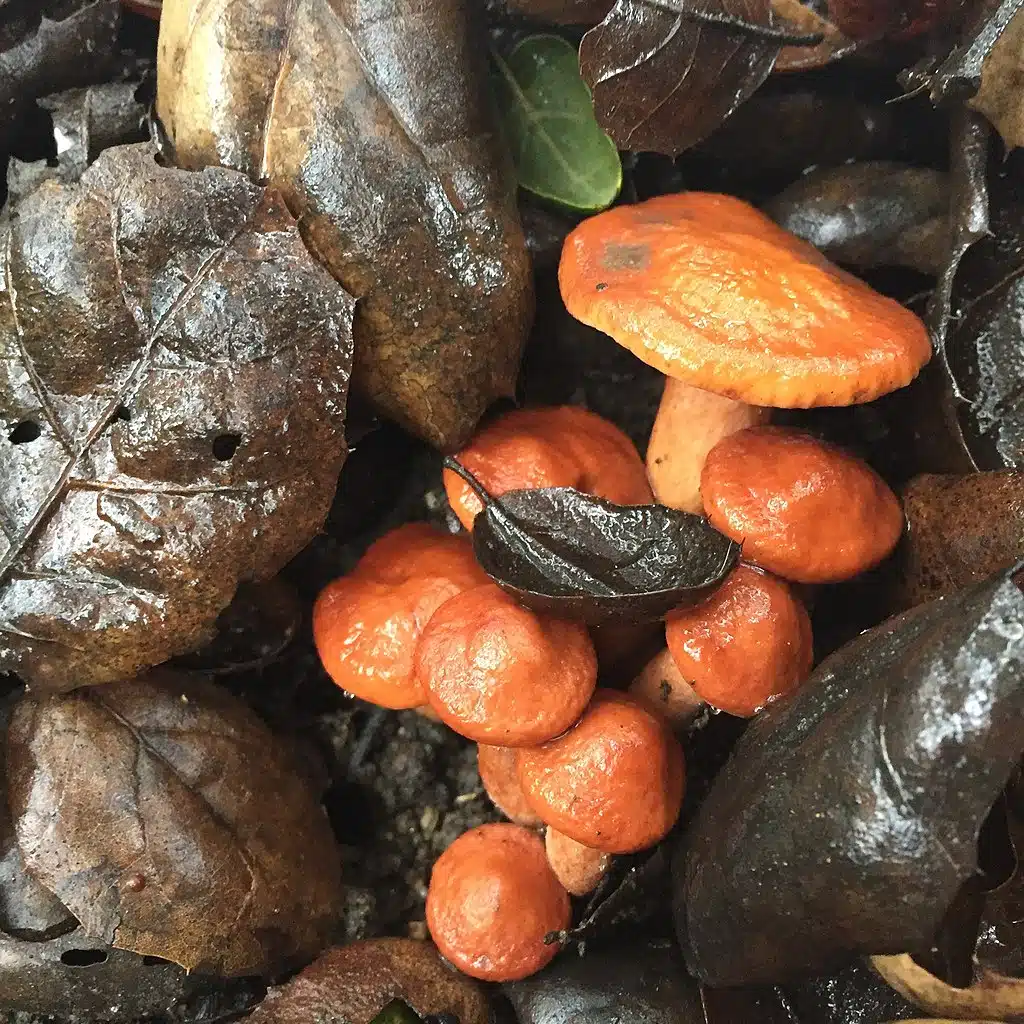
Brown-red nuances are characteristic of the cap of Rufous Candy Cap (Lactarius rufulus).
This species has a wider cap that may measure up to 3.9 inches in diameter while the stem can be as tall as 5 inches.
Once believed to only be a species of California, Rufous Candy Caps are also found in Northern Mexico.
Associated with oak trees, they benefit from the carbohydrates transported by these roots while the oak trees benefit from the protection of the fungi to their upper-level roots.
These types of mushrooms are edible and their sweet profile often recommends them for various deserts.
With a taste that resembles sugary maple syrup, the mushrooms can be picked and cooked in different ways.
20. Cherry-Red Waxy Cap
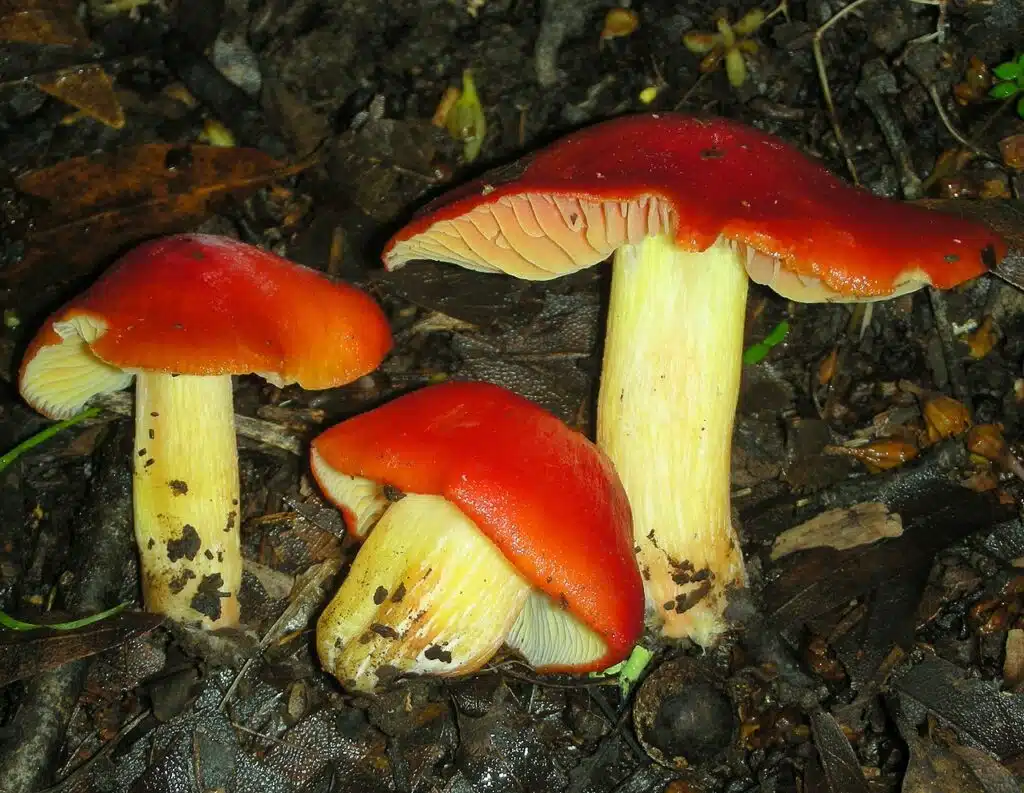
These types of mushrooms are named after their cherry-like cap color. This pale red nuance covers the upper bell-shaped cap of the mushroom while the rest of its body is white, cream, or yellow.
A species associated with pine woodlands, Cherry-Red Waxy Caps (Hygrocybe laetissima) are mostly specific to coastal forests in Western North America.
California’s forests are believed to be the habitat where these mushrooms are the most prevalent. Reports have them in high numbers up until Oregon.
The gills of these mushrooms are also bright. White at first, they turn yellow before turning completely red.
Mixed reports are tied to the edibility of Cherry-Red Waxy Caps. Some say they taste good while others say they are poisonous.
As a means of caution, it’s best to keep away from touching or eating the mushrooms.
21. Lilac Bolete
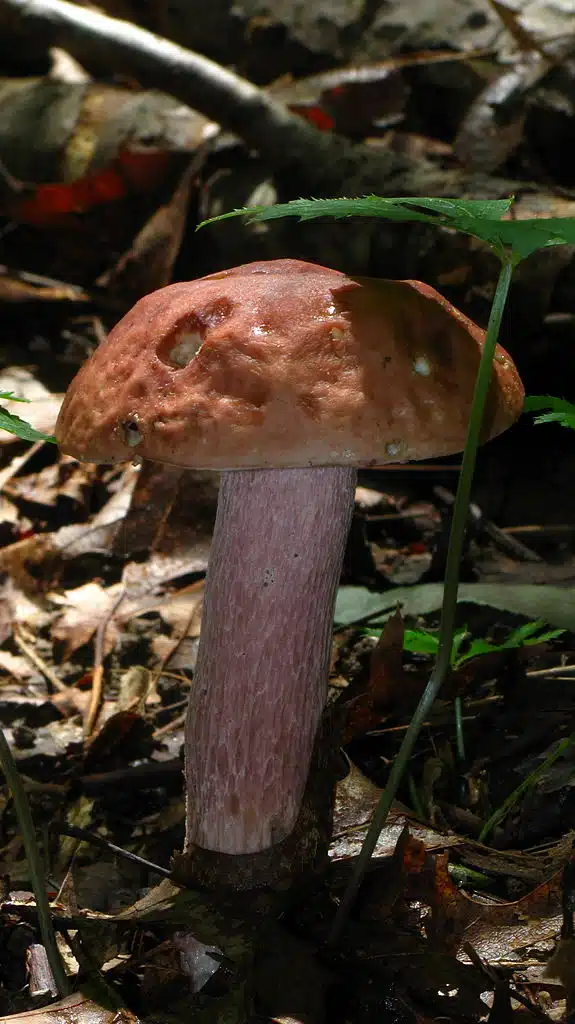
Lilac Boletes (Boletus separans) are some of the more common oak mushrooms. On occasion, these mushrooms also grow next to pine trees, not just in oak woodlands.
Sometimes large, they can grow to a maximum cap diameter of over 7 inches.
They additionally show a pale liver stem and a matching cap nuance. The nuance of the cap eventually darkens as the mushroom grows.
As a result, large Lilac Bolete Caps end up having a dark brown appearance.
These mushrooms can be further identified by their yellow gills.
In terms of habitat, the mushrooms are widespread across North American oak woodlands.
Almost all oak woodlands East of The Rocky Mountains are home to this species which tends to grow scarcely and in small numbers.
22. Bloody Brittlegill
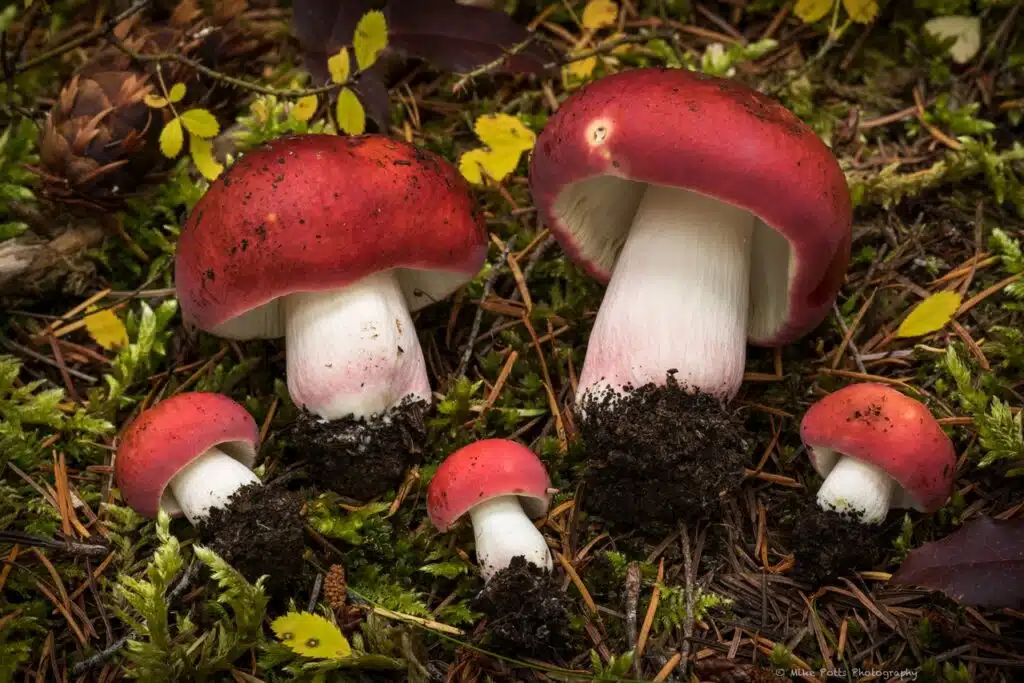
Rosey Russula or Bloody Brittlegill was known as Russula sanguinea to now become Russula Sanguinaria.
Its name is inspired by the Latin word sangue, which translates as blood, as a reference to its deep red cap.
The stem of these mushrooms is mostly white with a red base.
Mushrooms of this species are mostly found across coniferous woodlands both in Europe and North America.
Growing in small numbers in their natural habitat, these types of mushrooms reach a medium to large size with some of them reaching a cap diameter of around 4 inches.
The cap becomes convex or flattened as it reaches this large diameter.
While they may seem edible, these mushrooms are poisonous. Cooking them reduces their poisonous nature but still leads to upset stomachs or other complications.
Even more, Bloody Brittlegills have a spicy Sichuan pepper-like taste.
23. Gilled Bolete
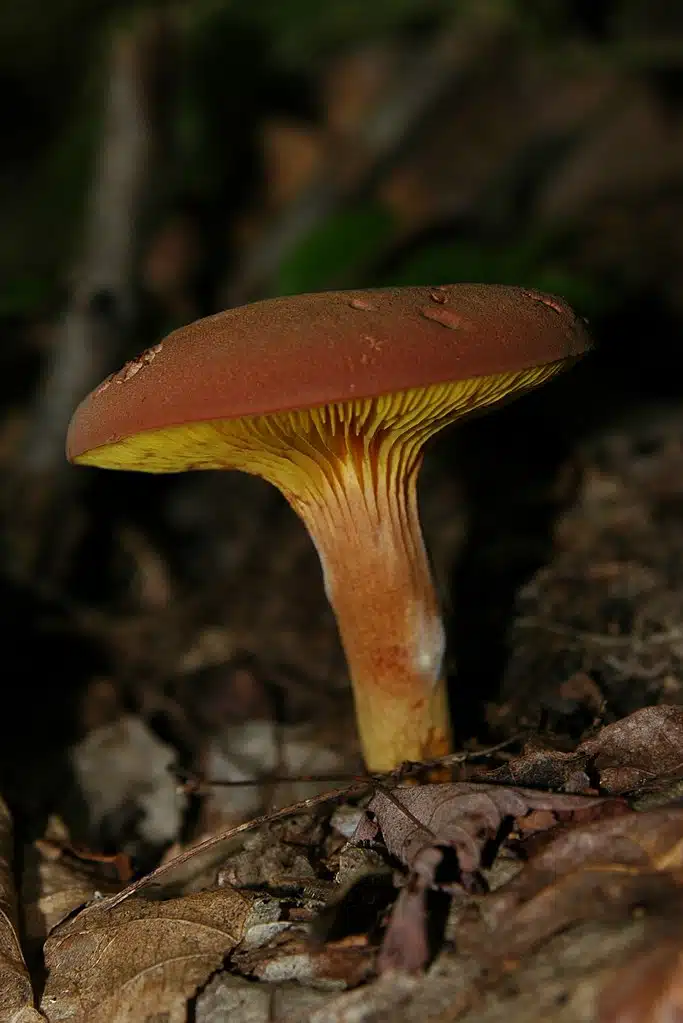
A species that comes in different shades of red and brown, Gilled Boletes (Phylloporus leucomycelinus) also grow to a cap diameter of several inches.
These mushrooms are found across North America in oak and pine woodlands.
Deep yellow gills are further specific to these mushrooms which are considered not worth picking by some and clearly edible by others.
Some of the most common types of uses for this mushroom include sautés.
It’s also believed Gilled Boletes have a nutty taste which further recommends them for vegan meals or as sides for meat-based dishes.
These mushrooms can be picked starting with July with a constant presence in woodlands up until mid-fall and the first frost.
24. Candy Apple Waxy Cap
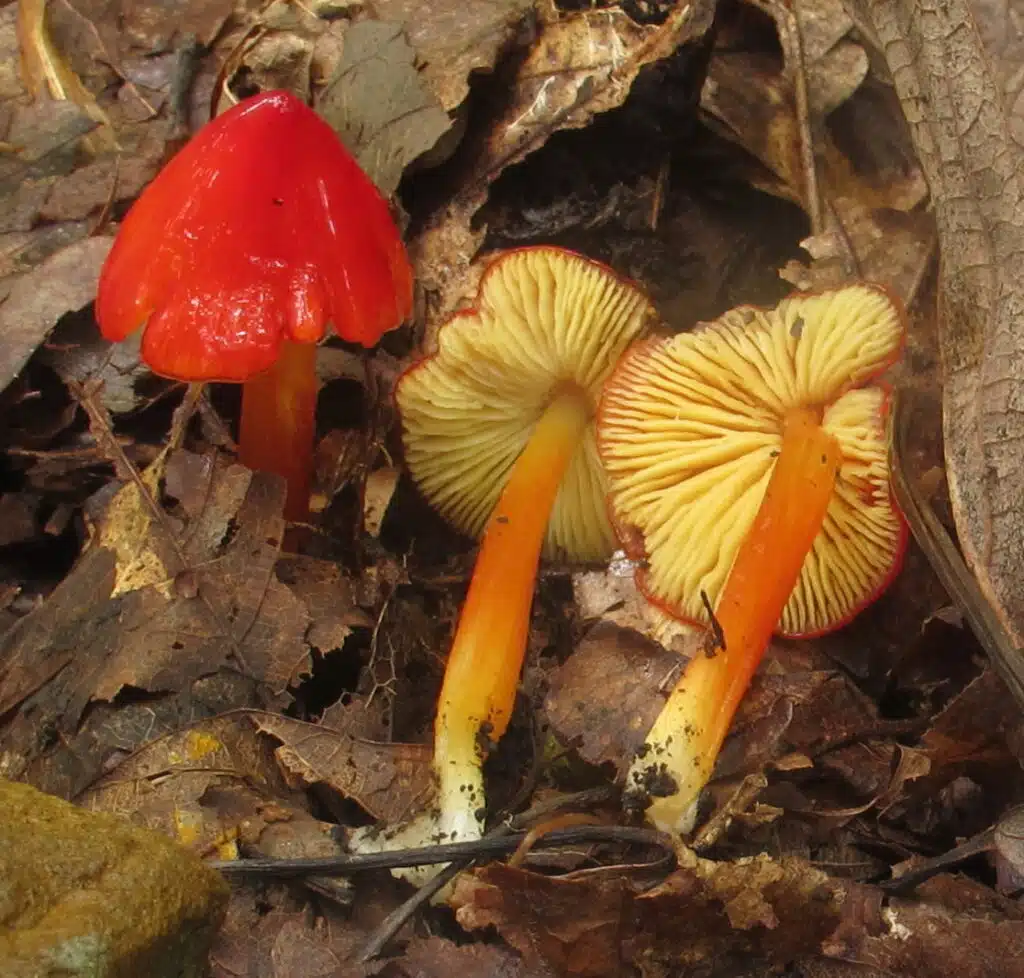
Deep forests are home to some of the most colorful types of red mushrooms such as The Candy Apple Waxy Cap (Hygrocybe cuspidata).
This species shows a deep red cap with an elevated central point. The shiny or glossy texture of the cap itself inspires its waxy name.
This species appears in low numbers under oaks, in areas close to their roots.
On occasion, these mushrooms can also be found in mixed woodlands and in other types of broadleaf hardwood woodlands.
A common sight in North American woodlands, the species isn’t considered edible.
25. Plums-and-Custard

With a maximum cap size of 4.7 inches, Plums-and-Custard (Tricholomopsis rutilans) are types of mushrooms generally referred to as Strawberry Mushrooms.
Their nickname is inspired by their strawberry-like color cap color while the stem is partly white.
Western Europe and Eastern North American forests are home to this species which is always seen in large groups where it grows.
Old, dead, or decaying pine roots are the ideal habitat for this species. They also grow in areas with mosses where they contrast the dark green ground.
The cone-shaped cap of the species darkens in time but its appearance generally remains colorful. These mushrooms aren’t edible and they have a bad taste as well.
Growing directly on dead pine trunks and fallen pine branches, these mushrooms make their appearance in mid-July, up until mid-fall.
26. Ruby Bonnet
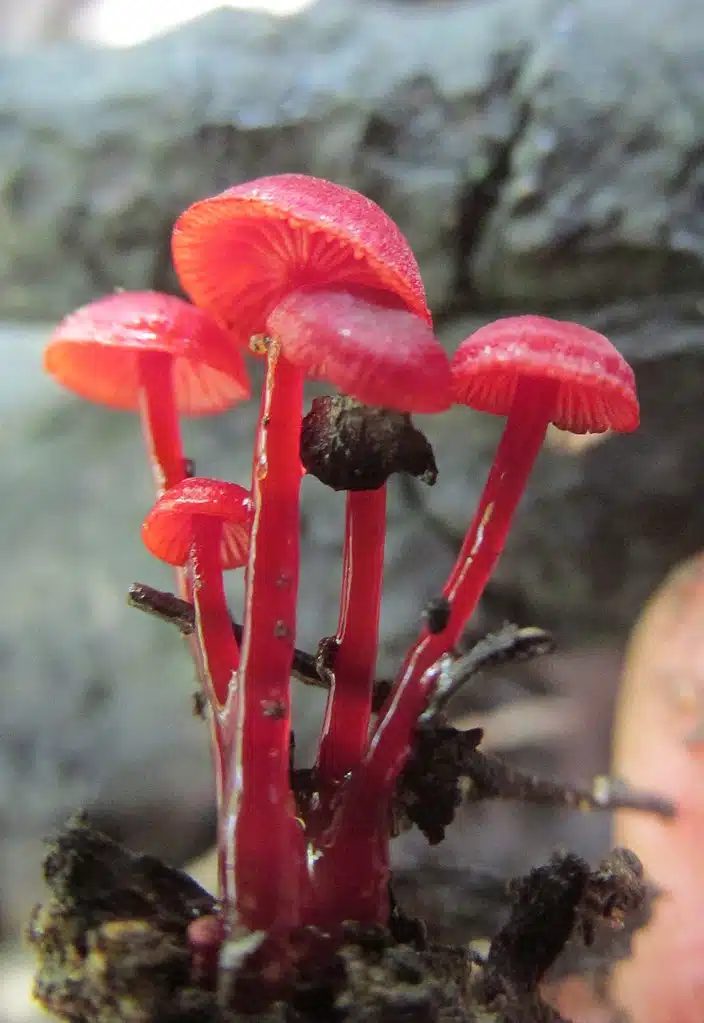
Dark ruby red nuances are specific to Ruby Bonnets (Cruentomycena viscidocruenta), a species found in Australia and New Zealand.
The gills and stems also have a red color and make the species easier to identify.
A species that isn’t edible, Ruby Bonnets are mostly spread throughout forests.
They appear late in the season and are even spotted in the winter.
Ruby Bonnets appear in remote areas but tend to spread by spores quickly. Growing directly out of dead wood, these types of mushrooms can appear in large clusters.
Some exceptions apply in terms of habitat. They can even appear on lawns and in parks, particularly in areas that don’t get regular maintenance.
27. Crimson Waxcap

Crimson Waxcaps (Hygrocybe punicea) are partly brown and turn crimson-brown as they grow.
These types of mushrooms reach a cap size of up to 3 inches, at best.
Europe marks its ideal habitat with high-elevation grassland, particularly in areas with mosses.
Since Crimson Waxcap only appears in areas with mosses, it’s believed there’s some type of relationship between the species as with mushrooms and the roots of trees.
While the mushroom is edible in some parts of the world, it’s believed not to be edible in others.
Britain and Ireland are the countries where this species is sometimes eaten. The mushroom is believed not to be edible when picked in North America.
Its season starts later and it also lasts into the start of the winter. Late August marks the appearance of the first mushrooms.
European Crimson Waxcaps also grow up until November.
28. Lacquered Bracket
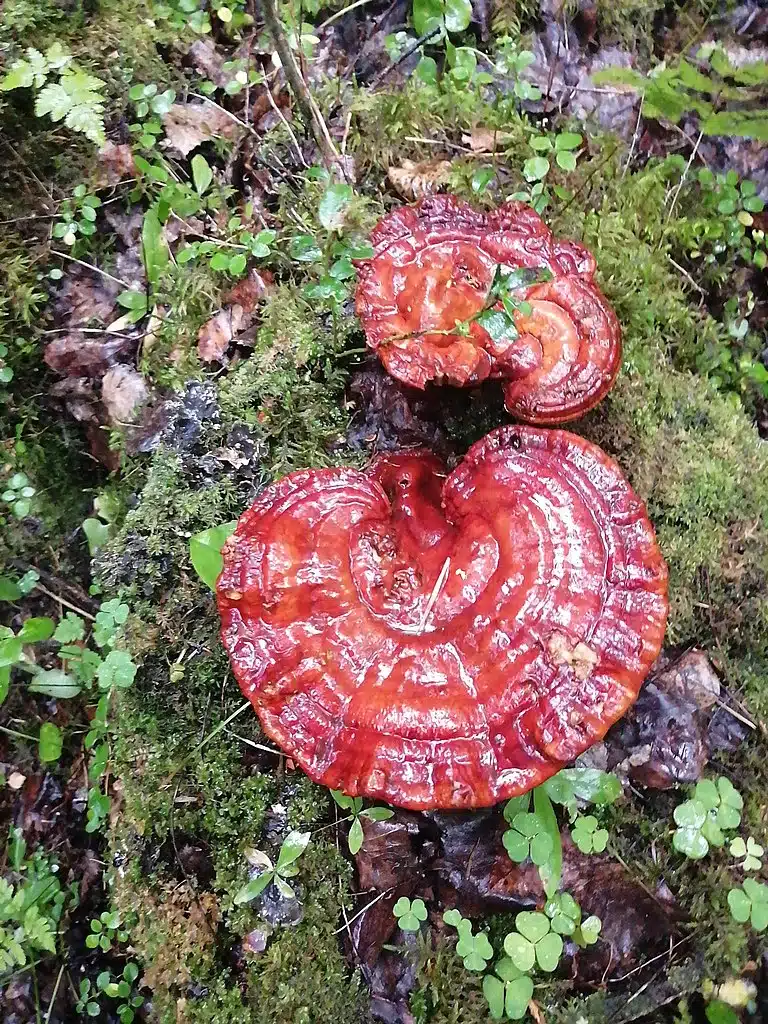
Some types of mushrooms only grow directly on trees, attached to the bark. Lacquered Brackets (Ganoderma lucidum) are these types of mushrooms, also known for their numerous presence in Japan and China.
Also found in Europe, this species is mostly known for its use in alternative medicine practices across Asia.
The species comes in different colors such as brown and red, all of them with a lacquered-like glossy appearance.
Its stem is short and less prominent than on other ground-level red mushrooms.
Different types of oak and even maple trees are attacked by this type of mushroom.
While Lacquered Brackets don’t grow on the ground, they grow close to the ground on the bark.
Not edible and even bad-tasting, these mushrooms are also present in North America.
29. Scarlet Pouch

Mostly red or red-brown with small caps, Scarlet Pouches (Leratiomyces erythrocephalus) are native to Australia and New Zealand.
Growth areas include forests but also gardens in areas with decorative woodchips.
Known for their long and sometimes curled stems, these mushrooms grow in large clusters over small spaces.
This species of mushroom is believed to have a long history. First documented more than 100 years ago, it has changed classifications a few times.
Scarlet Pouches are red mushrooms that are now found heavily in decaying vegetation both across France and the rest of mainland Europe as well as in Oceania.
30. Shaggy Cap
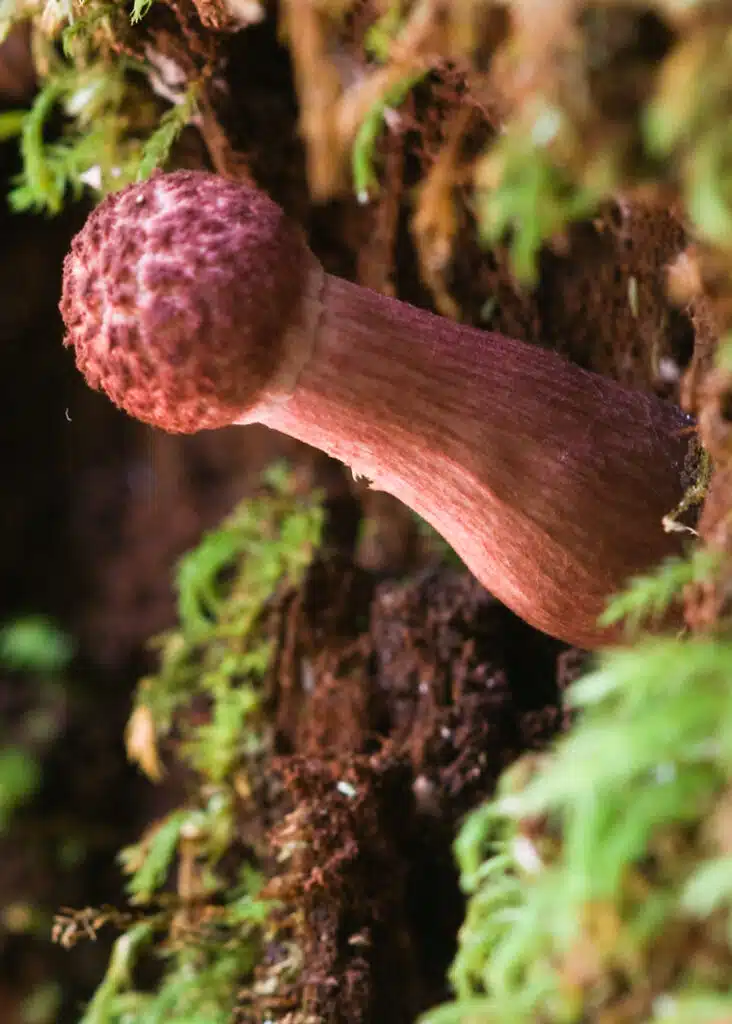
A species of rainforest, Shaggy Caps (Boletellus emodensis) has an atypical appearance. The red caps are shaggy and grow up to a size of 2 inches in diameter, rarely any larger.
They grow directly on eucalyptus or on beech logs on the ground where they also show short and sometimes curved stems.
These types of mushrooms are only specific to very large forests and eucalyptus forests are among the few places which house them.
Practically not edible, the mushroom darkens over time. Its cap becomes darker red while its pores become darker golden-yellow.
Finding these mushrooms is difficult due to their remote locations. Furthermore, they grow solitary and scarcely on dead eucalyptus which makes them easier to overlook.
In their early days, Shaggy Caps are completely red or pink-red.
31. Velvet Parachute
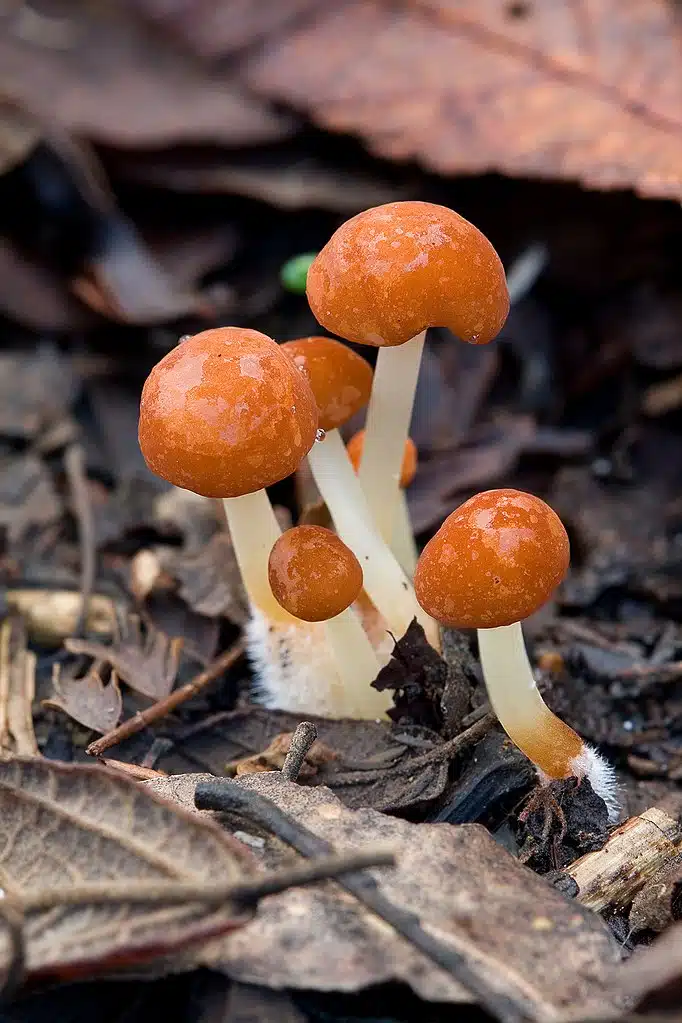
Multiple species of red mushrooms grow on eucalyptus logs and in eucalyptus forests.
Velvet Parachutes (Marasmius elegans) are among the small types of red mushrooms that grow on eucalyptus.
They feature a small cap that measures up to 1 inch with a red-brown nuance. The red nuance of the species can also be closer to orange, particularly in its early days.
The stipes have a mostly white appearance with red-brown bases.
When first arising on eucalyptus, both the cap and the stipe have a red-brown nuance, the stipe still being a bit brighter.
Velvet Parachute mushrooms tend to appear in clusters of up to tens of mushrooms on a single log.
This species is mostly found on Australian eucalyptus and is known to snap back to life even after drying out and appearing completely dead.
32. Curry Milkcap

A type of fungus in pine forests, Curry Milkcaps (Lactarius camphoratus) are found across Europe and North America.
These types of mushrooms have an all-red-brown appearance with a flattened cap and red-brown gills.
The scent of the species inspires its name as the mushrooms have a slight curry-like smell.
Mushrooms of the species are initially brighter red in their appearance. Closer to pink initially, they turn darker red to brown as they grow.
They are further known for having a white milk-like substance when broken.
Some of the areas where the mushrooms are found in high numbers include pine woodlands. On occasion, it can also be spotted in lower-elevation woodlands.
Curry Milkcaps are edible, but only when cooked. Largely scentless at first, they become curry-reminiscent after drying in the sun.
33. The Sickener
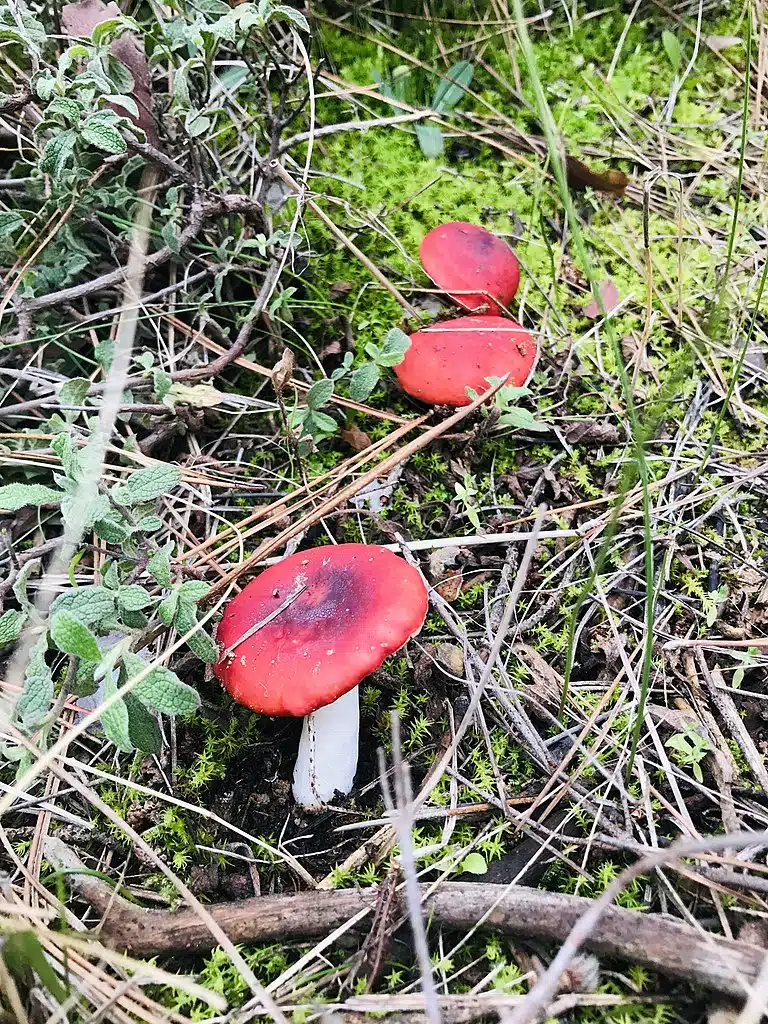
As their name suggests, these mushrooms can make you sick. An upset stomach is among the first symptoms described after accidentally ingesting the mushroom.
Highly poisonous, this mushroom has a bright red cap with raised edges and an all-white stipe.
Its gills are all-white, similar to the stipe.
These types of poisonous mushrooms are still eaten in some parts of the world, after being cooked.
It’s not best to eat them given they’re highly poisonous. Some of the first reactions such as nausea and vomiting install within an hour after eating The Sickener.
Most of these adverse reactions tend to go away on their own within a few hours of the ingested quantity being small.
The Sickener (Russula emetica) is one of the red mushrooms that grow in pine forests across Europe and Asia. They are also present in bare vegetated areas at high elevations in Russia, where they might be eaten against general recommendations.
34. Red-cage Fungus
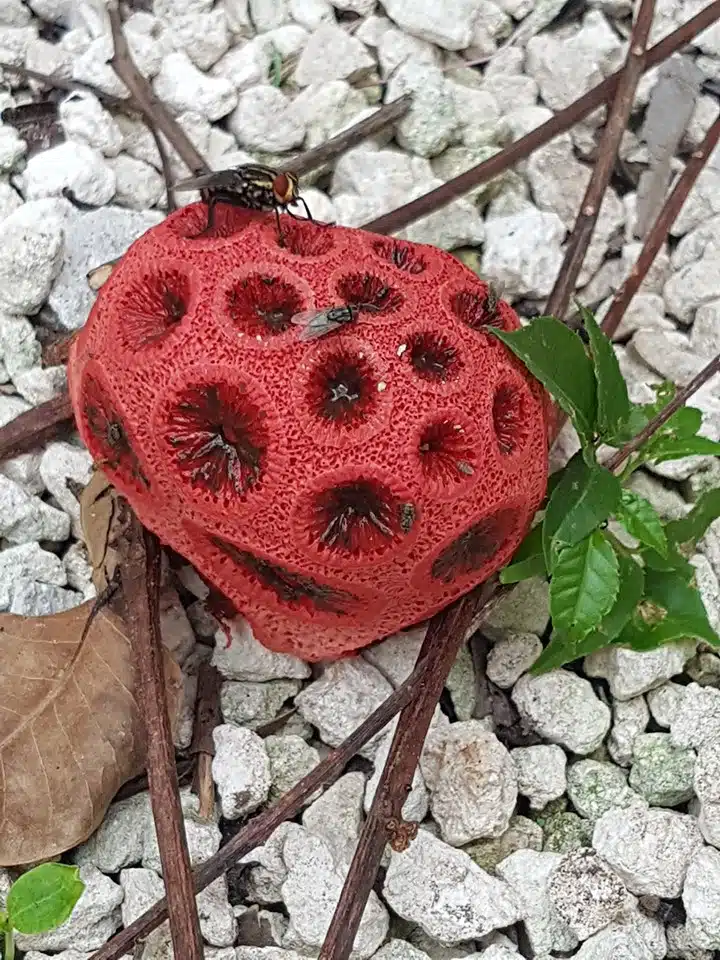
Not all types of red mushrooms have a typical cap-like appearance.
Red-cage fungi look more like hollowed weaved baskets with multiple holes.
Entirely red, this is a species with a constant presence across all continents. It has made its way to the entire world from Europe, with the advent of travel and colonization.
The species is now associated with decaying wood and it may even be spotted in garden mulches.
These mushrooms aren’t always red. They’re initially cream-orange as they come out of the vulva. This is also the stage when they are considered edible.
Young Red-cage Funguses (Clathrus ruber) are eaten in Europe where they retail for a high price. These mushrooms aren’t recommended for eating once they turn red, on the other hand.
35. Anemone Stinkhorn Fungus
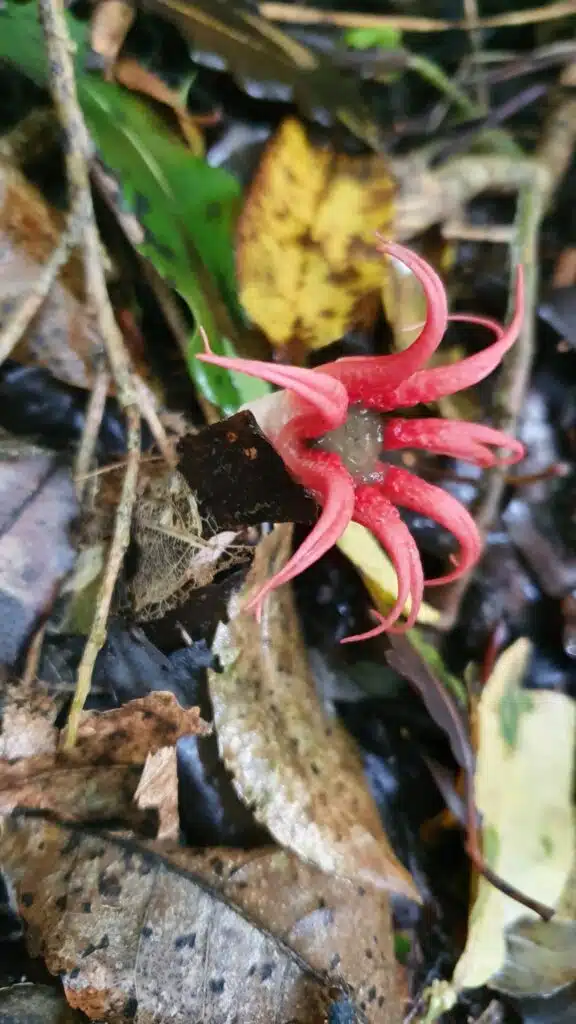
Some types of mushrooms, such as Anemone Sinkhorn Fungus (Aseroe rubra) have a flower-like appearance.
These tentacle-rich red mushrooms have an appearance that helps them thrive as visiting insects spread their spores.
Forests, parks, and grasslands of Australia and New Zealand are home to the species.
Anemone Sinkhorn Funguses feed on decaying plants and decaying plant material.
While they look interesting compared to other mushrooms, Anemone Stinkhorn Funguses aren’t the best in gardens as they smell similar to carrion.
This trait further helps them attract insects to spread spores.
36. Devil’s-Fingers
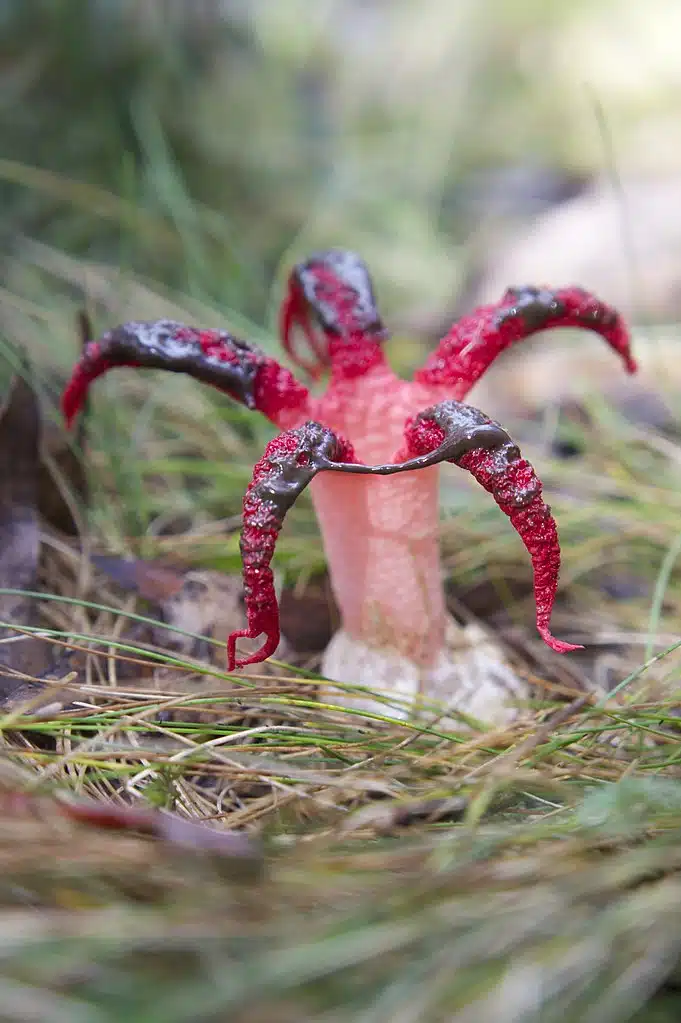
Similarly to Anemone Stinkhorn Fungus, Devil’s-Fingers (Clathrus archeri) mushrooms also attract plenty of attention with their red finger-like tentacles.
Also found in Australia and New Zealand, Devil’s-Fingers initially appears as a white egg on decaying vegetation and logs.
Its red tentacles eventually break out of the egg and sit up straight before bending like flower petals.
Not entirely red, these finger-like tentacles have black spots and stripes as well.
The presence of these mushrooms in gardens is quickly discovered as Devil’s-Fingers have an unpleasant scent compared to that of carrion.
However, for these mushrooms to grow, gardens need to have plenty of decaying vegetation and plenty of mulch.
While not as easy to find in Australia today, Devil’s-Fingers are expanding across Europe and North America.
37. Stinky Squid
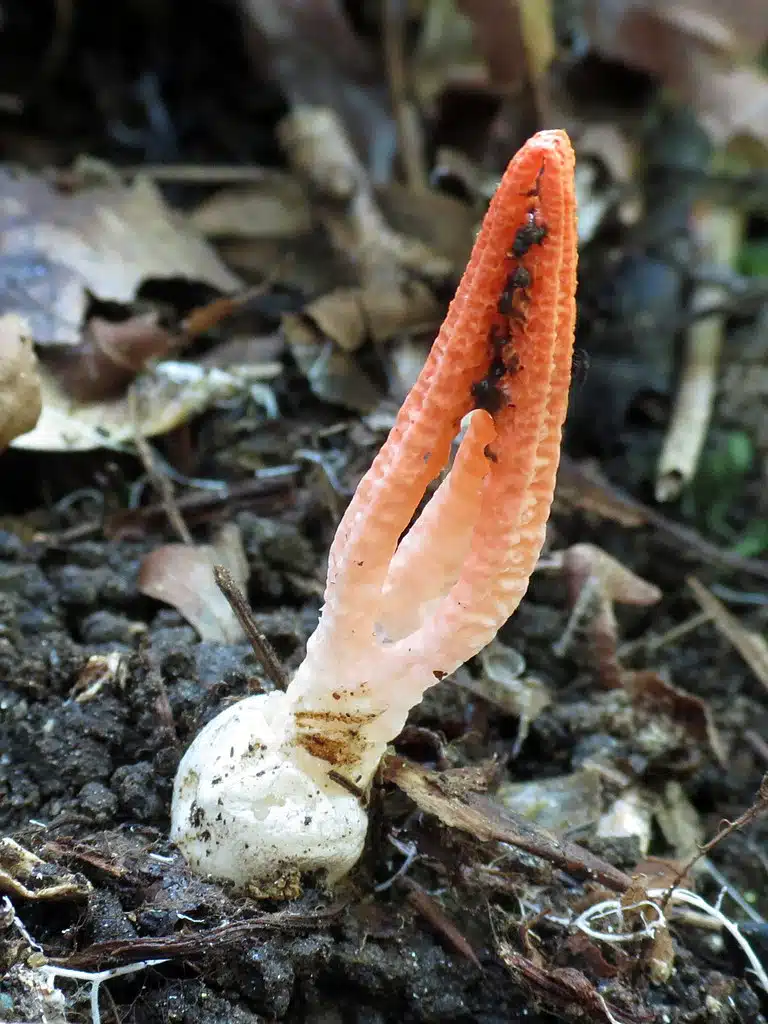
Another type of atypical mushroom, Stinky Squid (Pseudocolus fusiformis) resembles actual squid and it smells bad.
Its bad odor attracts insects that help spread its sports. 3 finger-like tentacles that are erect are specific to this mushroom.
These tentacles have bright red coloring and are joined at the top.
A species that grows on logs and decaying wood, it may occasionally be found on decorative mulch.
Most Stinky Squid prefers to live in forests. Found in coniferous forests across the world, this species has expanded to Europe, North America, and Australia.
The bad smell of Stinky Squid is sufficient to turn people away which makes these mushrooms not edible.
38. Beefsteak Polypore
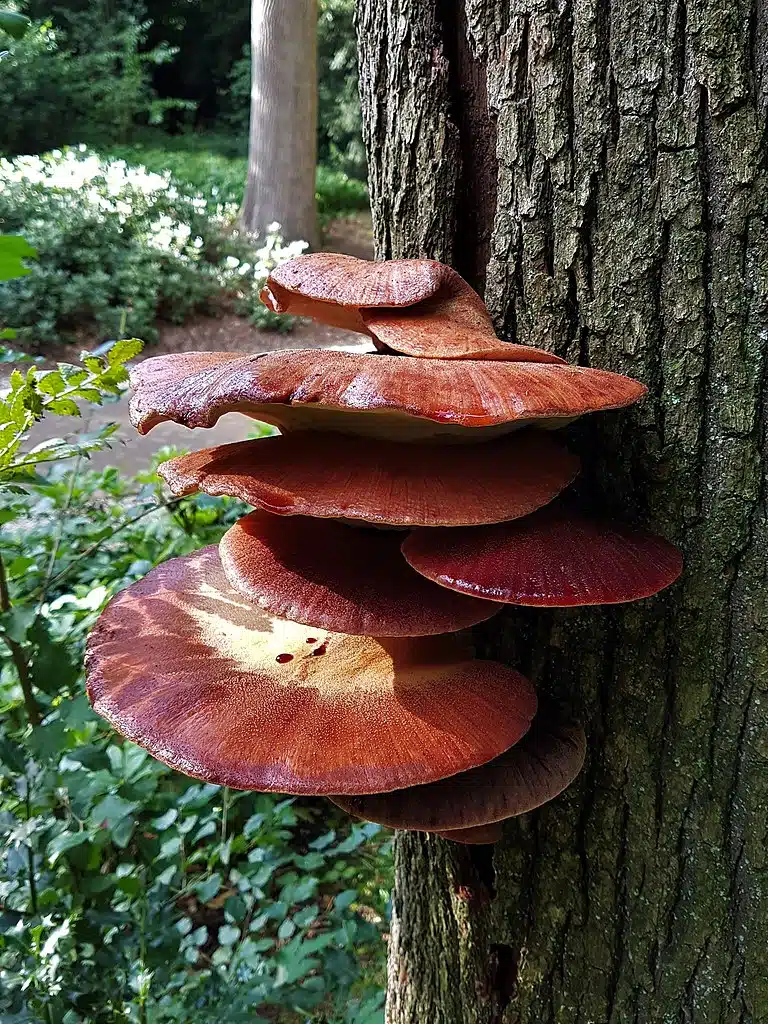
One of the oldest marketed types of mushrooms in Europe, Beefsteak Polypores (Fistulina hepatica) are among the common meat substitutes in some cultures.
These red-brown mushrooms are collected early and are said to resemble the taste of beef but with a slightly more acidic twist.
While they can be eaten after cooking, these mushrooms are hard and take longer to cook than other more readily available options.
Growing on dead wood, these mushrooms are further known for their deep red nuance as they grow.
The nuance of the species is enough to even leave a red-brown mark on the old logs it grows on.
Apart from its location and appearance, this species can be further identified by the red liquid that comes out when cut.
39. Scarlet Cup
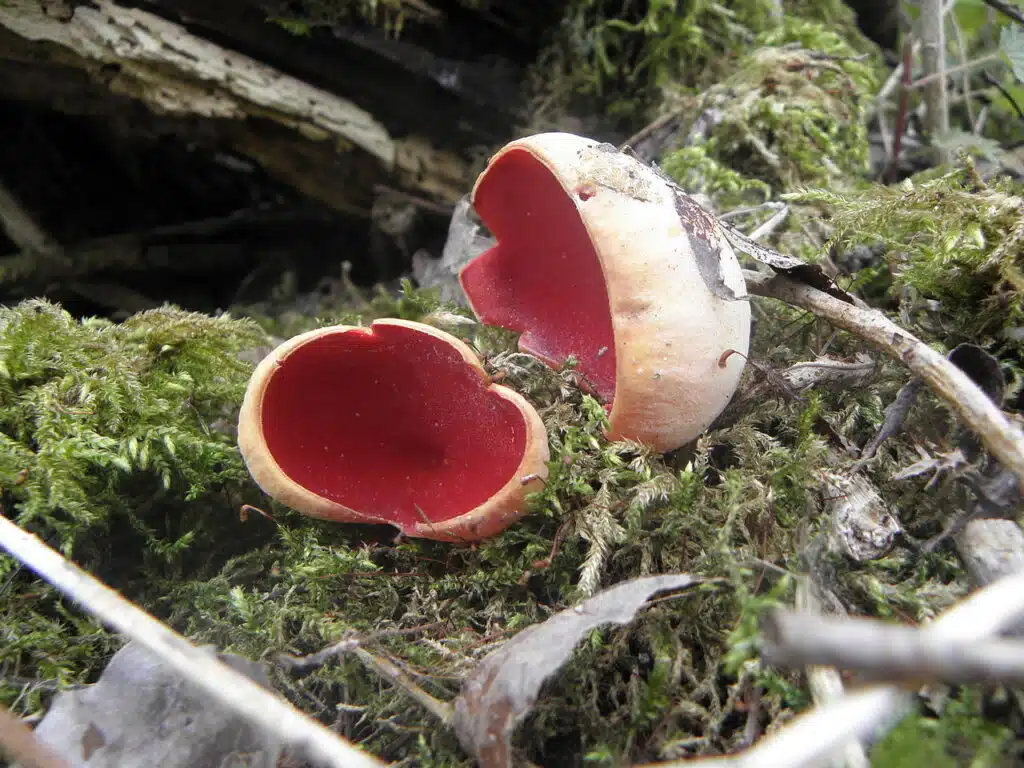
Scarlet nuances dominate the appearance of the Scarlet Cup (Sarcoscypha coccinea).
This type of fungi grows on decaying wood. Not all types of decaying wood can prompt its growth.
Old branches or tree trunks already buried underground are the ones Scarlet Cups grow on.
Often globe-shaped, this mushroom has brighter red coloring on the outside and darker red coloring on the inside.
Its edible status is unclear as some recommend eating it while others warn people to stay away.
Forests are the only area where these types of mushrooms are found today.
They grow on decaying wood such as old hazel branches buried under soil and vegetation.
Forests across Europe and North America are home to this type of mushroom which only arises at the end of the winter.